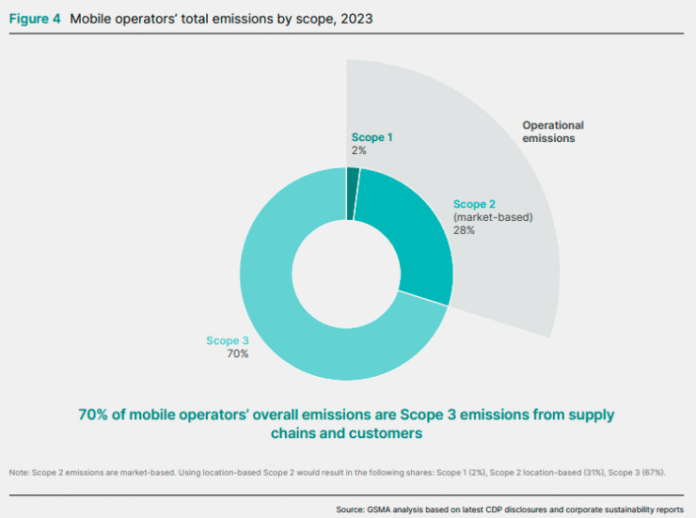Telecom operators are making measurable progress in reducing emissions, even as connectivity and data demands surge.
According to the GSMA’s fifth annual Mobile Net Zero report, mobile industry operational emissions fell by 8 percent between 2019 and 2023, while mobile connections increased by 9 percent and data traffic quadrupled. This decoupling of emissions from data growth signals that operators are taking concrete steps — not just commitments — towards climate goals.
Transition to Renewable Energy
One of the most significant levers telecoms are using to cut emissions is switching to clean electricity. In 2023, 37 percent of the electricity used by operators reporting to CDP came from renewable sources — up from just 13 percent in 2019. This shift avoided around 16 million tonnes of carbon emissions. Operators in markets with supportive policies have ramped up procurement of solar, wind, and other renewable sources, often supplemented by on-site solar and battery storage to reduce reliance on diesel generators.
China, the world’s largest mobile market, has begun turning the corner. In 2024, its telecom sector recorded a 4 percent drop in operational emissions — its first decline after years of growth — driven by a more than fourfold increase in renewable energy use.
Network Efficiency Improvements
Operators are also cutting emissions by modernizing their networks. This includes phasing out energy-intensive legacy systems like 2G and 3G, upgrading to more efficient 4G and 5G technologies, and deploying AI-driven energy management systems. Smart scheduling of network resources and hardware consolidation are helping reduce energy usage even as data traffic rises exponentially.
In high-performing regions such as Europe and North America, operational emissions fell by 56 percent and 44 percent respectively from 2019 to 2023 — reflecting both policy support and aggressive energy efficiency measures.
Science-Based Targets and Climate Roadmaps
As of 2024, 81 telecom operators—covering nearly half of global mobile connections —have set or committed to science-based emissions reduction targets. These targets guide reductions not only in direct (Scope 1 and 2) emissions but increasingly in Scope 3 emissions, which cover supply chain and product lifecycle impacts. Leading companies are also developing climate transition plans to assess climate risks and map out long-term decarbonization strategies.
Tackling Scope 3 and Embracing Circularity
Scope 3 emissions represent over two-thirds of the industry’s carbon footprint, largely from device manufacturing and logistics. Operators are beginning to address this through supplier engagement, sustainable procurement practices, and support for refurbished device markets.
Consumer appetite for sustainability is accelerating this shift. Around 90 percent of mobile users now say they value device longevity and repairability, and nearly half are open to buying refurbished phones. Operators are increasingly offering trade-in programs, certified refurbished options, and recycling initiatives to extend device lifespans and reduce the emissions embedded in new product manufacturing.
The Road Ahead
While recent progress is encouraging, the GSMA warns that emissions must fall by 7.5 percent annually through 2030 — more than double the current average — to remain on track for net zero by 2050. Sustaining momentum will require improved access to renewables, stronger policy support, and more coordinated action across the telecom ecosystem.
As Steven Moore, GSMA’s Head of Climate Action, notes: “The mobile industry isn’t greenwashing — it’s green acting. But to meet global goals, we must move faster and work together across supply chains, markets, and governments.”
Main highlights
The mobile industry has achieved notable progress in cutting carbon emissions, with operational emissions falling by 8 percent between 2019 and 2023 — even as mobile connections rose 9 percent and data traffic nearly quadrupled. This performance outpaces the global trend, where CO2 emissions increased by 3 percent during the same period, highlighting the telecom sector’s success in energy efficiency and renewable energy adoption.
Regionally, Europe led with a 56 percent reduction in emissions, followed by North America (44 percent) and Latin America (36 percent). While Greater China saw an 8 percent rise in emissions, it recorded a 7 percent drop in emissions per connection, with early 2024 data indicating its first year of absolute emission decline.
Electricity consumption by telecom operators rose 12 percent since 2019 to reach 290 TWh in 2023, equivalent to 1 percent of global electricity use. Greater China alone accounted for a 30 percent increase in usage. Despite this, global electricity use per connection remained flat at around 30 kWh. Networks, especially mobile access, account for the bulk of energy use.
AI-driven growth in data centres has pushed global energy demand in that sector up 50 percent since 2019, though its near-term impact on telecom network energy use is expected to be modest. AI applications may instead enhance network energy efficiency.
Renewable energy is playing a pivotal role in decarbonizing telecom operations, accounting for nearly half of emission reductions between 2022 and 2023. In 2023, 37 percent of electricity used by reporting operators came from renewables, up from 14 percent in 2019, avoiding 16 million tonnes of carbon emissions. Twelve operators fully matched their electricity use with renewable energy purchases last year.
GreentechLead.com News Desk

